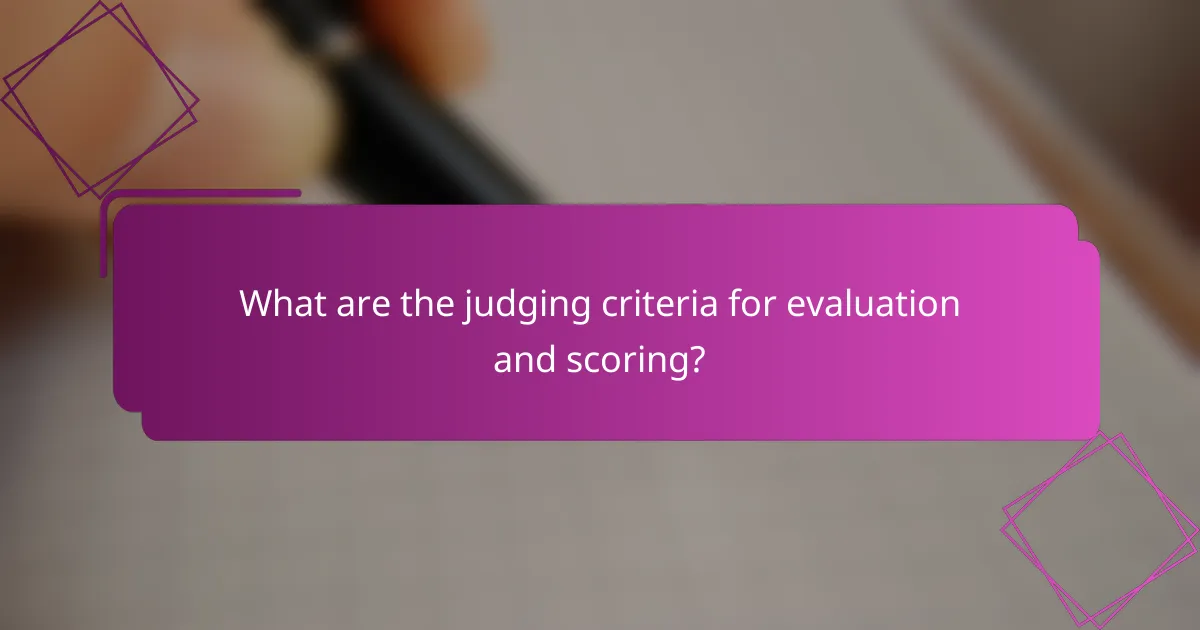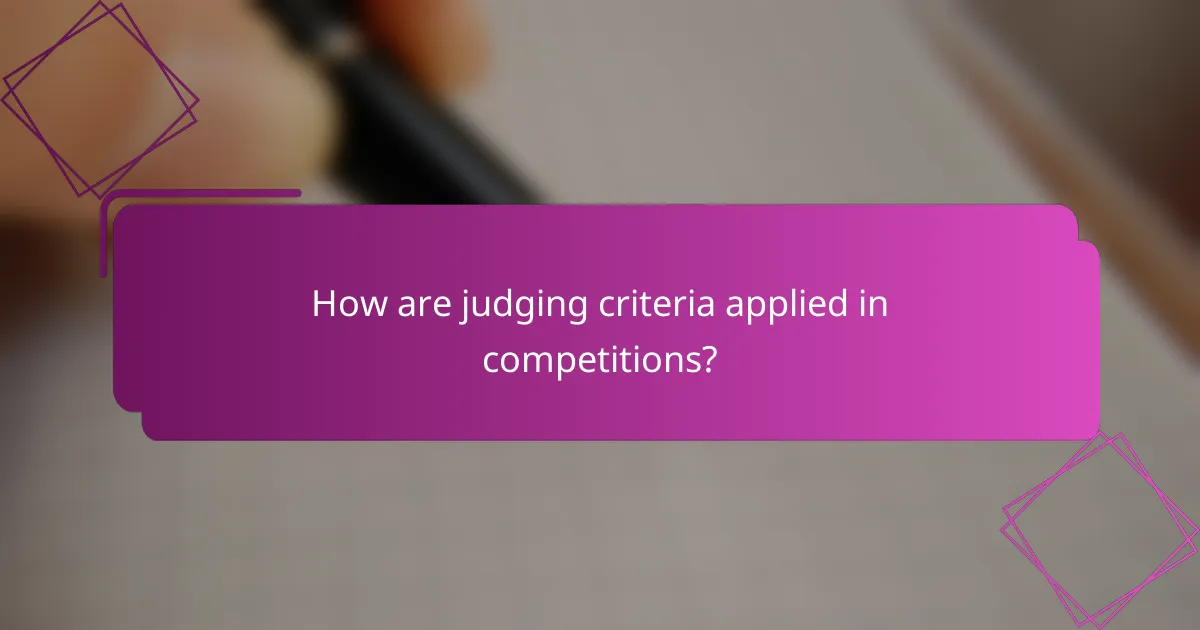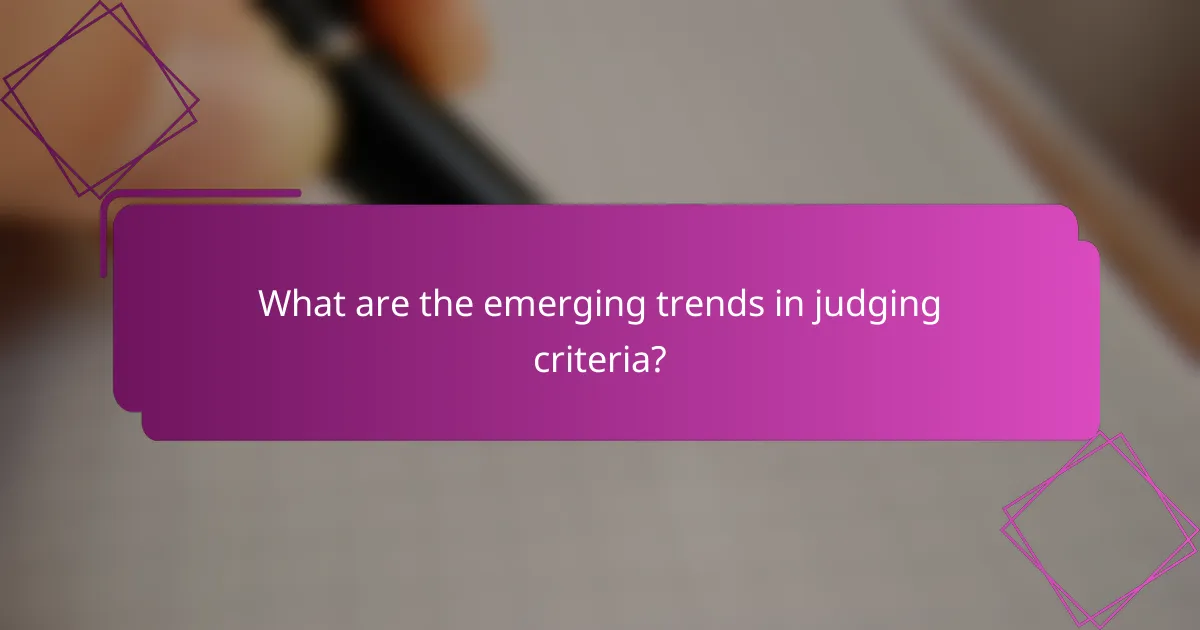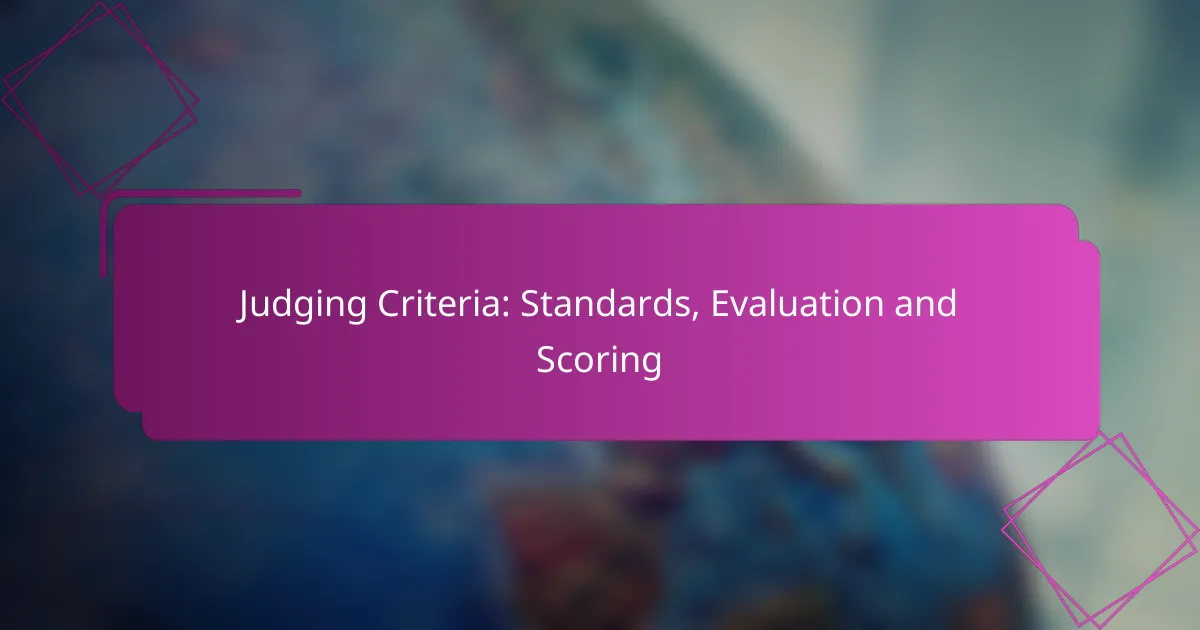Judging criteria play a crucial role in the evaluation and scoring process by providing a structured framework for assessing performance and quality. These criteria ensure fairness and consistency across various contexts, including competitions and reviews, by establishing clear and transparent standards. By involving relevant stakeholders in their development, organizations can enhance the accuracy and objectivity of their evaluations.

What are the judging criteria for evaluation and scoring?
The judging criteria for evaluation and scoring encompass a range of methods used to assess performance, quality, and effectiveness. These criteria help ensure a fair and consistent evaluation process across various contexts, including competitions, reviews, and assessments.
Standardized metrics
Standardized metrics are quantifiable measures that provide a consistent framework for evaluation. They often include specific criteria such as accuracy, speed, and efficiency, which can be compared across different entries or performances. For example, a competition might use a scoring range from 1 to 10 for each metric, ensuring uniformity in evaluation.
When using standardized metrics, it’s crucial to define each metric clearly and ensure that all judges understand how to apply them. This minimizes subjectivity and enhances the reliability of the scoring process.
Qualitative assessments
Qualitative assessments focus on subjective criteria that capture the nuances of performance not easily measured by numbers. This might include creativity, originality, and overall impact. Judges often provide written feedback to support their scores, which can offer valuable insights into the strengths and weaknesses of each entry.
To effectively implement qualitative assessments, it’s important to establish clear guidelines for judges to follow, ensuring that their evaluations are based on consistent criteria. This can help mitigate biases and improve the overall quality of feedback.
Quantitative measures
Quantitative measures involve numerical data that can be analyzed statistically. These measures might include performance metrics such as completion time, error rates, or production costs. For instance, in a coding competition, the number of bugs found in a program can serve as a quantitative measure of its quality.
Using quantitative measures allows for straightforward comparisons between entries. However, it’s essential to balance these with qualitative insights to provide a comprehensive evaluation of performance.
Industry benchmarks
Industry benchmarks serve as reference points that help evaluators gauge performance against established standards within a specific field. These benchmarks can include average scores, completion times, or success rates from previous competitions or industry reports. For example, a benchmark for customer service response time might be set at under 5 minutes.
Incorporating industry benchmarks into the evaluation process can enhance credibility and provide context for scores. Judges should be familiar with these benchmarks to ensure that evaluations are relevant and aligned with current industry standards.
Expert reviews
Expert reviews involve assessments made by individuals with significant experience or knowledge in a specific area. These experts can provide insights that go beyond standard metrics, offering a deeper understanding of the nuances involved in the evaluation. Their opinions can weigh heavily in the final scoring, especially in specialized fields.
To maximize the effectiveness of expert reviews, it’s beneficial to select reviewers who have a proven track record and are respected within the industry. This can enhance the legitimacy of the evaluation process and provide participants with valuable feedback for improvement.

How are judging criteria applied in competitions?
Judging criteria in competitions are essential for ensuring fairness and consistency in evaluations. They provide a structured framework for assessing participants based on predefined standards, which helps in delivering objective results.
Scoring systems
Scoring systems are the numerical methods used to quantify the performance of competitors. Common approaches include point-based systems, where judges assign scores within a range, and ranking systems, where participants are ordered based on their performance. For instance, a typical scoring range might be from 1 to 10, with specific criteria outlined for each score level.
When implementing a scoring system, it’s crucial to ensure clarity in what each score represents. This helps judges maintain consistency and reduces ambiguity in evaluations. A well-defined scoring rubric can enhance transparency and trust in the competition process.
Evaluation frameworks
Evaluation frameworks outline the criteria and processes judges use to assess competitors. These frameworks often include categories such as technical skill, creativity, and presentation. Each category may have specific indicators that judges look for, making the evaluation more comprehensive.
For effective evaluations, frameworks should be communicated clearly to both judges and participants. This transparency allows competitors to understand what is expected of them and helps judges apply the criteria uniformly. Regular reviews of the framework can also ensure it remains relevant and effective.
Judging panels
Judging panels consist of individuals selected to evaluate competitors based on the established criteria. The composition of these panels can vary, often including experts in the relevant field, industry professionals, or previous winners. A diverse panel can provide a broader perspective and enhance the credibility of the judging process.
To optimize the effectiveness of judging panels, it’s important to provide training on the scoring system and evaluation framework. This ensures all judges are aligned in their understanding and application of the criteria. Additionally, rotating panel members in different competitions can help mitigate biases and promote fairness in evaluations.

What are the best practices for establishing judging criteria?
Best practices for establishing judging criteria involve creating clear, consistent standards that reflect the goals of the evaluation process. These criteria should be transparent and involve input from relevant stakeholders to ensure fairness and accuracy.
Clear definitions
Clear definitions are essential for effective judging criteria. Each criterion should be explicitly defined to avoid ambiguity, ensuring that all judges have a uniform understanding of what is being evaluated. For example, if creativity is a criterion, specify what aspects of creativity are important, such as originality or innovation.
Using specific language helps judges apply the criteria consistently. Consider providing examples of what meets or does not meet the criteria, which can guide judges in their evaluations.
Stakeholder involvement
Involving stakeholders in the development of judging criteria enhances credibility and acceptance. Stakeholders can include participants, judges, and industry experts who provide valuable insights into what should be evaluated. Their input can help tailor the criteria to reflect the needs and expectations of the community.
Organizing workshops or surveys can facilitate this involvement, allowing stakeholders to voice their opinions and contribute to a more balanced set of criteria. This collaborative approach can lead to greater buy-in and satisfaction with the judging process.
Regular updates
Regular updates to judging criteria are crucial to maintain relevance and effectiveness. As industries evolve, so do the standards and expectations for evaluation. Periodically reviewing and revising the criteria ensures they remain aligned with current practices and innovations.
Establish a schedule for reviews, such as annually or biannually, and incorporate feedback from judges and participants. This practice not only improves the criteria but also demonstrates a commitment to continuous improvement in the evaluation process.

What tools assist in the evaluation process?
Various tools enhance the evaluation process by streamlining scoring, analyzing data, and collecting feedback. These tools help ensure that assessments are fair, consistent, and based on reliable information.
Scoring software
Scoring software automates the evaluation of submissions, allowing judges to input scores efficiently. These programs often include features like predefined criteria, which help maintain consistency across evaluations.
When selecting scoring software, consider user-friendliness and compatibility with existing systems. Popular options may include cloud-based solutions that facilitate real-time collaboration among judges.
Data analysis platforms
Data analysis platforms assist in interpreting evaluation results by providing insights into trends and patterns. These tools can aggregate scores and feedback, making it easier to identify strengths and weaknesses in submissions.
Look for platforms that offer visualization features, such as charts and graphs, to present data clearly. This can help stakeholders make informed decisions based on comprehensive analysis.
Feedback collection tools
Feedback collection tools enable judges to provide qualitative insights alongside quantitative scores. These tools can range from simple forms to sophisticated survey software that captures detailed comments.
Ensure that the feedback collection method is straightforward for judges to use, as this encourages more thoughtful and constructive responses. Consider integrating these tools with scoring software for a seamless evaluation experience.

How do cultural differences impact judging criteria?
Cultural differences significantly influence judging criteria by shaping the standards, values, and biases that evaluators bring to the process. These variations can affect how criteria are interpreted and applied, leading to diverse outcomes in evaluations across different regions.
Regional standards
Regional standards refer to the specific benchmarks and norms that are prevalent in different geographical areas. For instance, what is considered excellent in one culture may be viewed as average in another. Evaluators should familiarize themselves with local standards to ensure fair comparisons.
In some regions, strict adherence to guidelines may be expected, while others might prioritize creativity and innovation. Understanding these nuances can help judges align their evaluations with the expectations of the local context.
Value systems
Value systems encompass the beliefs and priorities that influence how individuals and groups assess performance. For example, collectivist cultures may emphasize teamwork and collaboration, while individualistic cultures might focus on personal achievement. These differing values can lead to varying interpretations of success.
Judges should consider how their own value systems align or conflict with those of the participants. This awareness can help mitigate biases and promote a more equitable judging process.
Judging biases
Judging biases are the preconceived notions and stereotypes that evaluators may unconsciously apply during assessments. These biases can stem from cultural backgrounds and can skew the evaluation process. For instance, judges might favor participants who share similar cultural traits or backgrounds.
To minimize the impact of biases, evaluators should engage in self-reflection and seek diverse perspectives. Implementing blind judging practices can also help reduce the influence of personal biases, leading to more objective evaluations.

What are the emerging trends in judging criteria?
Emerging trends in judging criteria focus on transparency, inclusivity, and the use of technology to enhance evaluation processes. These trends aim to create fairer and more accurate assessments across various fields, from competitions to academic evaluations.
Increased Transparency
Judging criteria are increasingly emphasizing transparency to build trust among participants and stakeholders. Clear guidelines and publicly available scoring rubrics help ensure that evaluations are understood and accepted by all involved.
For instance, competitions may publish detailed descriptions of how scores are calculated, allowing participants to see exactly how their performance is assessed. This practice encourages accountability and can lead to improved participant satisfaction.
Inclusivity in Evaluation
Inclusivity is becoming a central theme in judging criteria, as organizations strive to accommodate diverse backgrounds and perspectives. This trend involves creating criteria that are accessible and relevant to a broader audience.
For example, in academic settings, evaluation methods are adapting to consider different learning styles and cultural contexts. This approach not only enhances fairness but also enriches the evaluation process by incorporating varied viewpoints.
Technology-Driven Assessments
The integration of technology in judging criteria is transforming how evaluations are conducted. Tools such as AI and data analytics are being used to streamline scoring processes and provide more objective assessments.
Competitions might utilize software that analyzes performance metrics in real-time, offering immediate feedback to participants. This technology can enhance accuracy and reduce human bias, leading to more reliable outcomes.
